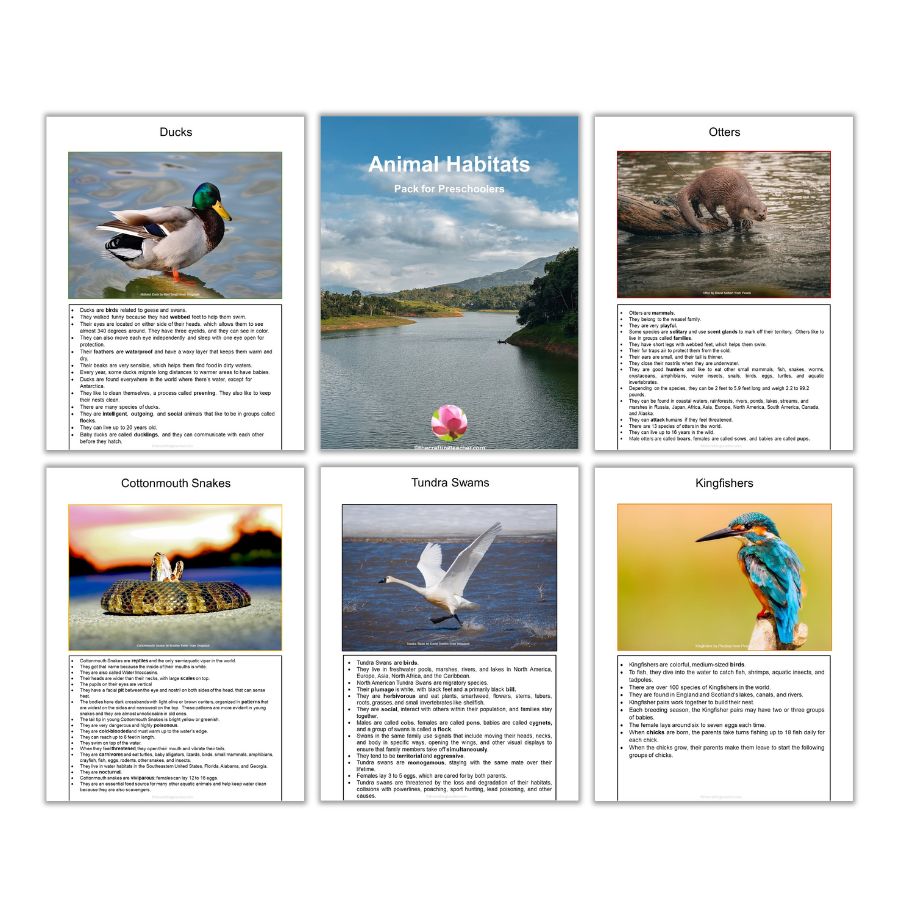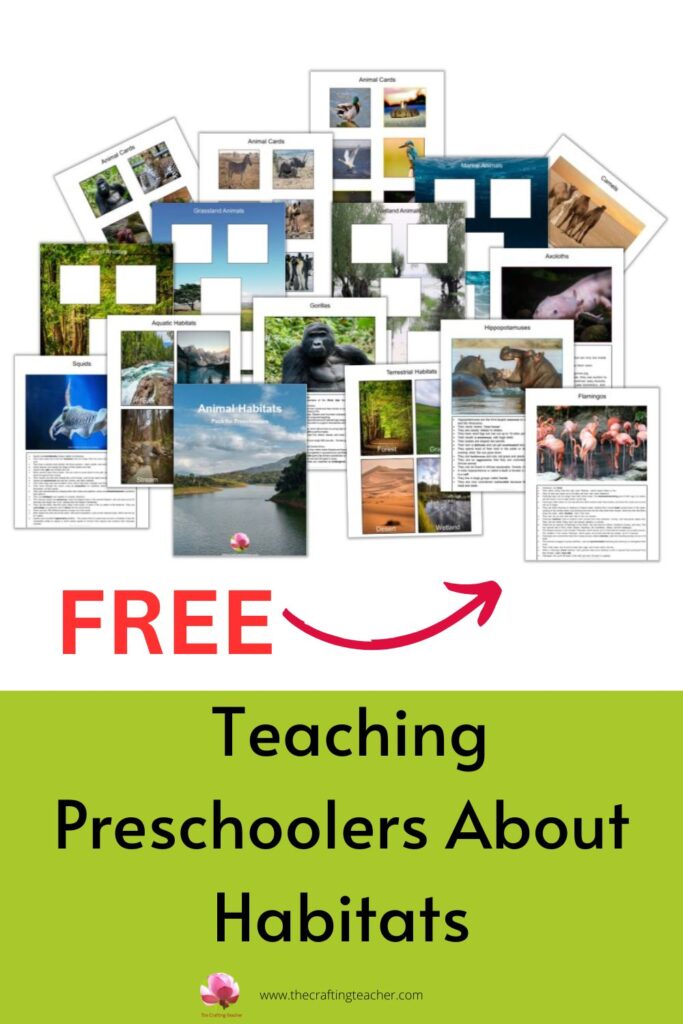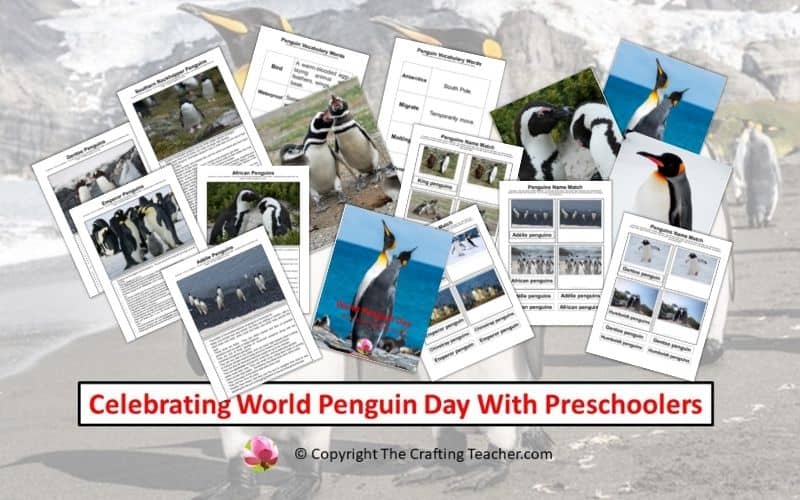Teaching Preschoolers About Habitats
Affiliate Disclosure: “This post contains affiliate links, which means I receive a small commission, at no extra cost to you, if you make a purchase using those links.”
Most children love learning about animals and wonder where they live and eat and how they survive in places as hot as deserts or cold as the Arctic. It is important to answer our preschoolers and teach them about some of those habitats, what animals live in them, and which are some of the most important adaptations that allow them to do it.

I’ve included a FREE 47-page Animal Habitats pack to help introduce your preschoolers to some of the main habitats and the animals that make them their home. You can get it at the end of this post.
What Is Habitat?
A habitat is the natural environment where specific plants and animal species live, providing the perfect conditions for those species to thrive and survive.

There are two main types of habitats, terrestrial and aquatic, subdivided into multiple types according to the region and climate. However, this is too complicated for preschoolers, so it is important to simplify it for them.
Since you can find the same type of animals in multiple habitats according to the species, I recommend teaching your children about some specific ones that cannot be found in various habitats to avoid confusion.
Types of Animal Habitats
There are two main types of habitats: terrestrial and aquatic.
Terrestrial Habitats
Terrestrial habitats are those on land. Animals in these habitats breathe in oxygen from the air using their lungs, have legs to walk on the ground, and some have wings to fly in the sky.
Here are some of the terrestrial habitats:
Forest: Places with many trees that receive a lot of rain. Some animals in this habitat are gorillas, leopards, orangutans, sloths, and brown bears.

Grasslands: Places with a lot of grass and some trees that receive only some rain. This habitat includes elephants, zebras, rhinos, ostriches, and Painted dogs.

Deserts: Places that are arid, with very little vegetation, and receive very little rain. You can find kangaroos, Emperor penguins, rattlesnakes, Arctic foxes, and camels in this habitat.

Wetlands: Places where the soil is covered with water. Among the animals in this habitat are ducks, otters, Cottonmouth snakes, Tundra swans, and Kingfishers.

Aquatic Habitats
Aquatic habitats are those underwater. Animals in these habitats breathe in oxygen from the water using their gills or have to go to the surface to breathe air, and some have fins to swim.
Some aquatic habitats are:
Freshwater: Water bodies with low salt content, such as rivers, lakes, and streams. Some freshwater animals are the newts, axolotls, Giant water bugs, hippopotamus, and flamingos.

Marine: This type includes oceans and seas that contain a lot of salt and where marine life is present, such as jellyfish, sea turtles, squids, whales, and octopuses.

Activities To Help Preschoolers Learn Animal Habitats
Teaching children about different habitats and some animals that live in them is an excellent way to introduce science to classrooms or homeschooling, bring them closer to nature, and encourage respect and love for it.
Numerous activities will help you in this journey. Here are some ideas:
Sorting and Matching
Collect some small plastic animals or images of different animals and ask your children to separate the terrestrial and aquatic animals.
Once you talk about the main habitats and the animals that live in each, you can also use the habitat mats and animal cards provided in the pack and invite your children to place the cards in the correct habitat where those animals live.

You can also use the same cards or plastic animals to match the ones that are the same or live in the same type of habitat, separate the ones that have legs from the ones that have fins or wings, and the animals that have fur from the ones that have skin or feathers, or sort them by mammals, fish, reptiles, or birds.
Another idea is to give a child an animal picture and ask the child questions about that animal, such as “What type of animal is this, terrestrial or aquatic?” or “Do you know in which habitat this animal lives?”
Sorting and matching activities help preschoolers develop essential skills, such as language, hand-eye coordination, concentration, memorization, visual perception, mathematical concepts, classification, fine motor, cognitive, and social skills.
Field Trips and Nature Walks
There’s no better knowledge than practical knowledge. Taking your children to visit different habitats, such as a river, a pond, your local park or garden, or the ocean, can help them use all of their senses, learn better about their characteristics, and see some of the animals that live in those habitats.
These visits can help them improve their attention span and foster a connection and understanding with the natural world as they use their senses to observe and explore, identify natural elements, and promote love and respect for these environments and the animals that live there.
They can also help preschoolers develop essential skills such as observation, communication, cognitive development, language and vocabulary, gross motor and social skills, critical thinking, literacy, memory, and empathy.
Watching Documentaries
Most preschool teachers find field trips and nature walks difficult or impossible. Therefore, showing your children documentaries about animal habitats is an excellent way to help them learn about those places and the animals you teach about.
Showing documentaries encourages children to engage in visual learning by watching real-life presentations, promotes language and communication, and helps students develop a deeper understanding of science concepts, empathy, and critical thinking. Below are two you can use.
Drawing, Coloring and Painting
Children love to draw, color, and paint. You can use this and invite your students to draw an animal from a particular habitat. Then, when they are finished, you can ask each of them to talk to you about the animal they draw and take dictation of what they tell you.
You can even take a step above and use their drawings to create a class book about habitats.
These activities help children improve their fine motor skills, hand-eye coordination, critical thinking, vocabulary, and communication.
Animal Letters Game
To encourage learning the letters of the alphabet, you can use small plastic animals or the animals provided in the pack, especially if you turn the activity into a game.
You can ask your children to name an animal with some of each of the alphabet letters and talk about the habitats in which they think that animal lives.
For example, if they say “W is for Whale,” then you can discuss the whales and where they live.
You can then invite them to write, trace, or copy those letters and the names of the animals to add practicing fine motor and pre-writing skills to the activity.
When preschoolers learn the names of animals, they develop many skills, including vocabulary, communication, pronunciation, teamwork, categorization, taking turns, emotional expression, and science.
Learning Zoology
I know this word sounds too big for preschoolers, but the reality is that teaching your children about some of the animals that live in different habitats is the part of science that teaches zoology.
I’ve included cards in the pack with the most essential information about each animal I suggested for the different habitats. Since your children cannot read yet, use these cards to teach about these animals and spark conversations about them and the habitats they inhabit.
You can also show your children one animal picture at a time and ask them questions about it, such as, “Where does this animal live?” “What type of habitat is that?” or “Is this a terrestrial or aquatic habitat?”
Learning about these animals develops multiple skills, such as scientific thinking, communication, language, problem-solving, observation, and critical thinking.
Dramatizations
Invite your students to act out animals and their corresponding habitats. You can also turn this activity into a game, where a child pretends to be an animal, and the rest try to guess which animal it is.
This activity promotes nonverbal communication, creativity, imagination, teamwork, vocabulary, social skills, problem-solving, gross motor, cognitive, collaboration, teamwork, and vocabulary development skills.
Sculpting and Imprinting
Children can make animal or habitat sculptures using play dough, and you can use this opportunity to ask them questions about the animal they sculpted.
They can also use plastic animals to print tracks using tempera paint, wet sand, or play dough. Then, you can turn this activity into a game where you show a print, and the children try to identify which animal made it, which will give them a better understanding of animal behavior and movement.
These excellent hands-on activities can help children develop various learning skills, including fine motor skills, hand-eye coordination, creativity and imagination, problem-solving, literacy, listening, scientific and math concepts, print awareness, visual perception, and social-emotional skills.
Sensory Bins Playing
Another hands-on activity that is excellent for preschoolers is playing with sensory bins. These bins can be easy to assemble using natural materials like sand, rocks, branches, leaves, and toy animals, providing a tactile learning experience.
A sensory bin can help preschoolers develop various learning skills, including fine motor, language, sensory integration, cognitive and social development, and emotional regulation.
Doing Puzzles
Another educational and fun hands-on activity that preschoolers enjoy is putting puzzles together. This activity helps them develop various learning skills, including fine motor skills, hand-eye coordination, problem-solving, visual perception, spatial awareness, memory, concentration, sequencing, and social skills.
Books About Habitats
As I mentioned before, there is no such thing as too much reading for me. The more you read to your children, the better. Changing your library periodically according to the theme and season is essential to keep them interested and excited about books.
Below are some books about habitats. You can find all these books at your local library, a used books store, and on Amazon. To get to the page of a specific book on Amazon, you only have to click on the title, and my affiliate link will take you there in seconds.
Who Lives Here? Polar Animals by Deborah Hodge discusses the polar regions and the amazing animals whose bodies are built for living in the extreme cold, finding food, and raising their young in a polar habitat of thick ice and snow.
Who Lives Here? Desert Animals by Deborah Hodge explains how each animal’s body is suited to live in this arid place, using realistic illustrations, playful language, and intriguing facts.
Who Lives Here? Rainforest Animals by Deborah Hodge describes the animals whose bodies are built for living among tall trees and lush green plants. They have unique ways of finding food, staying safe, and raising their young in a warm, wet tropical forest.
Who Lives Here? Forest Animals by Deborah Hodge describes how the forest is home to incredible animals whose bodies are built for living among the trees in cold weather. Black bears, wolverines, loons, and other animals have particular ways of keeping warm, finding food, and raising their young in a forest habitat with lakes and rivers, short summers, and long winters.
Who Lives Here? Savanna Animals by Deborah Hodge describes the savanna, home to exciting animals whose bodies are suited to living on the warm, grassy plain. Elephants, giraffes, lions, meerkats, zebras, and other animals have special ways of finding food, raising families, and protecting themselves in this habitat with long dry seasons and shorter rainy seasons.
Who Lives Here? Wetland Animals by Deborah Hodge. Wetlands are home to unique animals whose bodies are built for living in or near water. Hippos, crocodiles, and anacondas have particular ways of finding food, staying safe, and raising their young in a watery habitat.
A Home Can Be…. by Stephanie Seidler. From a floating house on the water to a treehouse built high in the branches, each page showcases a new and unique dwelling, celebrating the diversity of habitats and the creativity of those who make them.
About Habitats: Oceans by Cathryn Sin uses simple, easy-to-understand language and beautifully detailed paintings to teach children about oceans, the kinds of animals and plants that live there, and why oceans are essential.
Tall, Tall Tree by Anthony D. Fredericks discusses the magnificent California coast redwood, the animals that live there, and its surrounding environment, using a counting format and rhyming text.
Animal Homes by Shira Evans is a National Geographic book that uses brilliant photos to introduce children to vocabulary in concept groups, help them connect words, and expand their understanding of the world.
Animal Habitats by Lundgren teaches children about different species of animals and the habitats they use for food and protection.
Pin It For Later
If you are in a rush and don’t have time to read the post and download the printable but want to save it for later, pin this to one of your boards on Pinterest.

We know that not all children learn the same way. They may be visual, kinesthetic, or auditory learners. That is why it is vital to provide different activities, especially hands-on ones, to cater to all your children’s needs or to determine what works best for them and improve their learning abilities.
All my suggested activities can be easily adapted or modified to meet your children’s needs. I hope you find them helpful in teaching your kids about habitats. Don’t forget to get your FREE Habitats pack. Click on the bottom below to download it and start using it.
Be happy, safe, and creative. I wish you well.
Love,

P.S. Please let me know if this activity works for you, and if you would like to see an article or a printable about how to make something specific, please let me know, and I will try my best to create it for you.








Wow, incredible blog format! How lengthy have you ever been blogging for?
you made running a blog look easy. The entire look
of your web site is magnificent, as well as the
content material!
My goal is to educate and advocate for nature, especially endangered species, and your kind words motivate me to keep on trying. Thank you so much.
Very interesting subject, thanks for putting up.
Hello Ebony. You are very welcome! I appreciate your feedback. Thank you! I’m glad you like it.